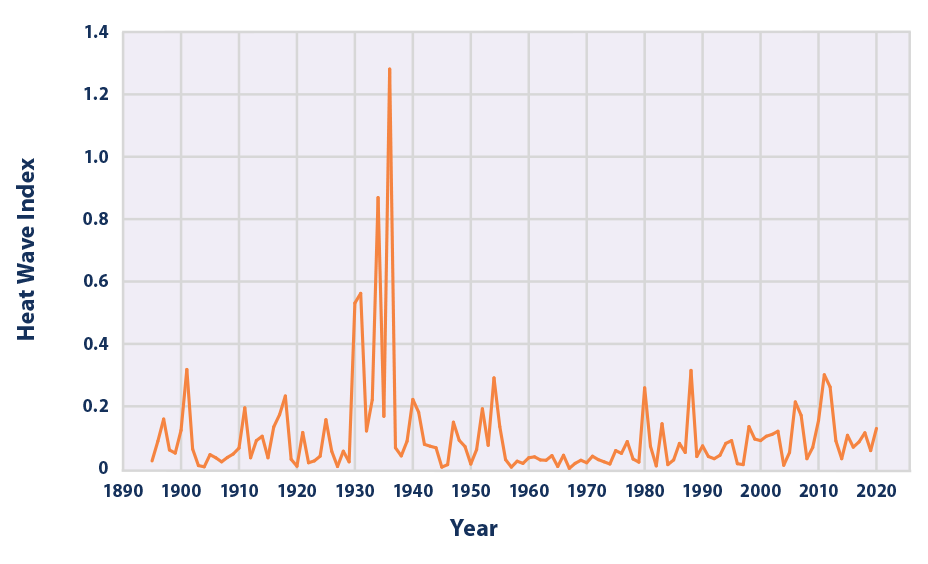A recent article from The Associated Press (AP) claims that, in New Mexico in 2020, climate change caused rapid switches from heat to cold over just a few days, which when combined with wildfires, ended up causing migratory bird deaths in the thousands. This is misleading, at best. While it is possible that combined effects of weather events may have led to the bird deaths, weather data shows that heatwaves are not getting worse over time, extreme cold trends are declining, and wildfires are also below historic levels. The fact that none of these events are getting more extreme or frequent refutes the claim that climate change caused the conditions and thus the bird deaths.
The article, “Thousands of migratory birds dropped dead in NM, possibly due to climate change,” describes research done by the Los Alamos National Laboratory on an event from 2020 in which “thousands” of migrating birds died. The researchers attribute the deaths to climate change, reporting to a local Albuquerque TV station that the combination of high temperatures in Colorado and New Mexico, followed by a cold front, and smoke from “large catastrophic forest fires in the region” contributed to the deaths.
Another professor involved in so-called “disaster ecology” was quoted by the AP saying that “[c]limate change is increasing the frequency and the severity of these weather-related events.”
These claims are untrue.
Heatwaves have not been getting more frequent or intense. In fact, as discussed in Climate at a Glance: U.S. Heatwaves, according to data from the National Oceanic and Atmospheric Administration, there has been no significant upwards trend in high temperature anomalies, shown in Figure 1 below.

Additionally, the worst period of extreme heat waves was in the 1930s, shown by Figure 2 below, which displays the Environmental Protection Agency’s, “Climate Change Indicators: Heat Waves,” data.

As can be seen in the graphic above, there was no dramatic heat spike in 2020.
The cold autumn of 2020 was widely reported then, and almost immediately blamed for early migration of birds, as discussed in a Climate Realism post, “Cold Autumn Kills Thousands of Birds – Media Blame Global Warming.” At that time, the deaths were attributed to starvation, but the weather was blamed for the early migration season. However, early cold snaps are not unusual, nor are they becoming more common amid modest global warming. The U.N. Intergovernmental Panel on Climate Change reports that it is “virtually certain” that cold weather extremes are declining.
The Los Alamos researcher’s claims about wildfires, uncritically parroted by the AP, are equally unconvincing. Data shows wildfires are not getting more severe, nor are conditions becoming more favorable for them. There has been a substantial decline in wildfire occurrences, as Climate Realism has reported numerous times, including here, here, and here, since the peak in the 1930s. There is a recent trend towards more acres burned since the 1980s, however this due to a shift in land and wildfire management policies.
While a combination of early migration spurred by a cold snap in autumn, and smoke from wildfires may have contributed to the migrating birds’ unfortunate deaths, to attribute this to climate change is unjustified by the evidence. The AP neglected to report the facts that there is no increasing trend in heat waves, cold snaps, or weather-driven wildfires. The article ends on the promise of more research to come tying the bird deaths to climate change. Rather than assuming the cause and then marshalling evidence to prove the preconception, the scientists ought to follow the scientific method, which means testing their hypothesis, that climate change caused 2022’s massive bird die off in New Mexico, against reality. That would mean rejecting the hypothesis because it is undermined by the data.



















On my recommended reading list for today
https://honestclimatescience.blogspot.com/2023/01/the-best-climate-science-and-energy.html
Migratory birds fall from the sky caused by the associated presses profound untrue stories on anything they talk about. This should be the headline. it has as much truth as their headline.
Whats the real Hazard to the Birds is Wind Turbines and Solar Panels which the Eco-Freaks have want t o use to replace convential and more relaible Power Sources